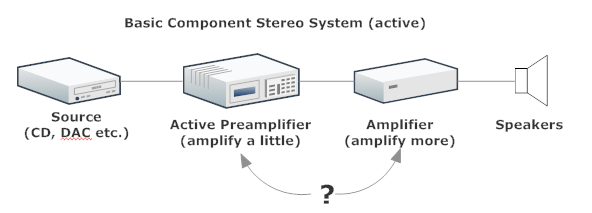The Perfect Preamplifier
If you read enough articles on high-end audio you eventually encounter the definition of a perfect preamp: no preamp at all. Just a short wire between the line source and the amplifier. Purity of audio signal maintained unsullied by intervening gear.
All fine and good provided you live alone, have few neighbors nearby, and don’t give a fig about going deaf.
Let’s move on.

An Active Preamplifier
Next you have the active preamplifier which typifies most component (or for that matter integrated) stereo audio systems. Positioned between the source and the amp, the typical active preamp does four things:
- Attenuates the source signal (controls the volume)
- Selects input (where there’s more than a single connected source)
- Buffers (electronically isolates) the input from the output (making impedance mismatch moot)
- Boosts the voltage level of the source signal (it amplifies the incoming audio signal).

What we have here is a low gain amplifier in front of a high gain amplifier. Why have two amplifiers in series – ever – when one will do just fine thank you? If you subscribe to the “less-is-more” school of audio design, the less “stuff” the audio signal has to go through on its way from source to speaker the better. While generally true, the devil’s always in the details.
Are there exceptions when an active preamp is warranted? Yes. Here are two key reasons:
- Low Output Sources: Some line-level sources (tuner, CD player etc.) may simply not have enough gain to “drive” an amplifier directly. A 2 volt (peak) output is typical with most recent source gear but anything above 0.75 volt should be ok as well. Unfortunately, older or consumer grade components may have line voltages below 0.5 volt in which case you may need an active preamp.
- Impedance Mismatch: When source components with high output impedance (say > 1,000 ohms) are mated with amplifiers with a low input impedance (say < 10,000 ohms), you are likely to experience flat flabby sound where the high frequencies are rolled off and the bass lacks punch; in which case you will definitely need an active preamp (or new source, or new amp!)
If your system has these characteristics, an active preamp will probably be needed to give you system sufficient dynamic “whomp” to provide a satisfying listening experience.
But the reality is that most line stage sources today (CD transports, DACs etc. ) have sufficient output voltage levels as well as low enough output impedance to require neither preamplification nor buffering. Also tube amps are generally very high impedance devices as are most (but not all) contemporary solid state amps.
A Passive Preamplifier
Which brings us to passive preamplifiers. An unapologetic oxymoron, a passive preamplifier does not amplify (or buffer); hence the adjective “passive”. Compared to active preamps, a typical passive preamp does only two things and often just one:Attenuates the source signal (controls the volume)
- Selects input (where there’s more than a single connected source)
Buffers (electronically isolates) the input from the output (making impedance mismatch moot)Boosts the voltage level of the source signal (it amplifies the incoming audio signal).

But that “one thing” that a passive preamp always does, it does very very well. In a very real way, the passive preamp comes close to being that perfect “just a short wire between the line source and the amplifier”; except with the civilized addition of volume control.
What it comes down to is this.
If your line source is able to “drive” the load (the amplifier), a passive preamplifier will usually sound better than even the best active preamplifiers. Open, alive, natural and neutral are all common descriptors of a passive preamplifier. A well matched passive system will play loud and clear and be fun to listen to.
Thou Shalt Audition
Theory,. guidelines and even test data can only take you so far. The best way to know if a passive preamp will work with your system is to audition one.
Tortuga Audio offers a generous 30 day audition policy on all of its LDR preamps.
Try it. We think you’ll like love it.
